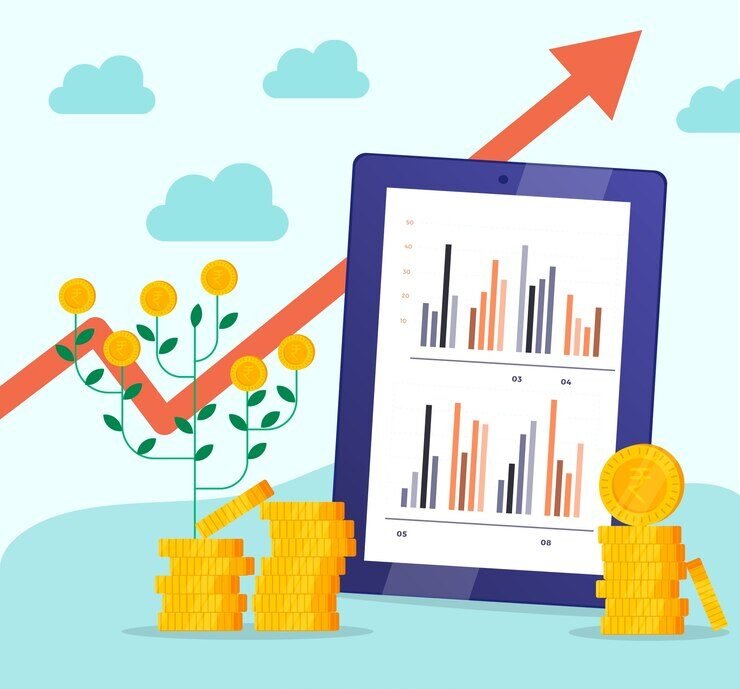The most frequent questions investors have are: how much will my investments increase over the next ten, fifteen, or any other years? Or, what will my assets be worth in ten years, and so on? This is where an investment’s future value comes into play.
A rupee deposited today into a savings account could be worth more than a rupee in a year. How does that work? Your rupee makes money for that year, thanks to interest payments from the bank. The value of a rupee deposited today will therefore increase in the future; the same is true of investments.
What Is The Future Value?
Future value (FV) is the value of an investment at a future date on the basis of a presumed growth rate. The future value is significant to investors and financial planners, as they can approximate the worth of their present investment in the future.
Estimating its future worth can be challenging depending on the type of asset. Moreover, a constant growth rate is assumed to estimate future value. For instance, when money is deposited in a savings account with a guaranteed interest rate, it is simple to calculate the future value accurately. However, investing in stocks or other securities with a more unpredictable rate of return might be more challenging.
For example, future value can be used to estimate how long it will take a property buyer to save ₹100,000 for a down payment.
Advantages Of Future Value
- Allows Planning
A business or investor may be aware of their current situation and be able to make certain predictions about what will occur in the future. This way, they can plan for the future as they comprehend their financial situation.
- Eases Comparisons
Assume a potential investor weighs their options. One calls for a ₹5,000 investment that will yield 10% over the following three years. The other takes a ₹3,000 investment and yields 5% in year one, 10% in year two, and 35% in year three. Only by projecting future values and comparing the results will an investor be able to determine which investment has the potential to yield the highest returns.
- Easy to calculate
Future value does not require complex math. Anyone can use future value as it relies heavily on estimates.
Disadvantages Of Future Value
- Unrealistic
Usually, future value assumes a steady growth rate. Only one interest rate is considered for computing future value. Even though variable interest rates can be used to assess future value, the calculations become more difficult and illogical. In reality, a situation might have various parameters because growth isn’t always linear or constant year over year, but just a streamlined formula that just considers rate.
- Inaccurate assumptions
The calculations are merely estimates because the future value is predicated on assumptions about the future, which may or may not be accurate. For instance, the earlier computation of future value is useless if the market is unable to generate that projected return.
- Failed comparisons
To compare the two projects, there are some restrictions. Consider the following scenario: An investor has the option of investing ₹10,000 for a predicted return of 1% or ₹100 for a predicted return of 700%. The first alternative may seem preferable if we were simply considering future value because it is higher; however, this ignores the initial investments.
How To Calculate Future Value?
Future value calculations are of two types:
Future value of a lump sum: It represents the value of a single deposit acquired over time.
Future value of an annuity: It is the value of a series of payments over time.
Formula For Future Value (FV) of a Lump Sum
FV = PV x (1+r)n
PV = Deposit or present value
r = Rate of interest over a period of time
n = The number of periods
Formula For Future Value (FV) of an Annuity
FV = PMT x [(1+r)n – 1]/r
PMT = Payment or contribution
r = Rate of interest over a period of time
n = The number of periods
Examples Of Future Value
The future value of an annuity formula can be used to determine how much a retirement account would be worth in 30 years if you contribute ₹2,400 per year (₹200 per month). Assume a 7% annual rate of return for this example:
FV = 2,400 x [(1+0.07)30 – 1)]/0.07
= 2,400 x [7.612 – 1] / 0.07
= 2,400 x 94.461
= 226,706
Although you would put in a total of ₹72,000 over the course of 30 years, due to the time value of money and the effect of compound interest, your account would be worth ₹226,706 (assuming an annual rate of return of 7%), or more than three times what you put in.
Let’s say you wish to estimate the worth of a ₹1,00,000 investment after 10 years at a 12% return. ₹1,00,000 invested today at a 12% return over a ten-year period will be worth ₹3,10,585₹. Moreover, assume the rate of return you anticipate achieving your investment if you are not investing in a fixed return instrument.
This can help you determine the future value of your objective. Let’s put it this way: if education inflation is 12% annually, how much would you pay for a computer course that costs ₹1,00,000 now after 10 years?
Similarly, the final value of the monthly investment would be close to 16 lakh if you invested 10,000 each month for eight years, assuming 12% annual returns, exactly like we do SIP in a mutual fund.
The mix of stocks, bonds, and other investments in your portfolio can also be determined using future value. A financial goal can be attained with less money invested if the rate of interest or return is higher. However, bigger returns typically come with a higher risk of losing money.
The formula for future value can also be used to determine the future value of your present expenses. And once you have a general concept of the numbers to come, you may make investment plans appropriately.
Conclusion
All financial planning, from buying or leasing a car to choosing a business to invest in new machinery, is based on the time value of money. Time and money are affected by future worth. Making wise financial decisions can be aided by using future value and other metrics.
FAQs
Does future value include inflation?
The rate of return on investment may also be affected by inflation adjustments. Even while it is possible to accurately forecast an asset’s future value given a stable interest rate, doing so is not always practicable.
Is future value compound interest?
The future value formula aids in figuring out the final sum, which accounts for the initial investment and all applicable interest. The “present value” of compound interest is the initial investment. The initial investment sum plus all interest is the “future value.”
Why is future value important?
Future value is important as it informs investors and other individuals about the future value of the current investment.









